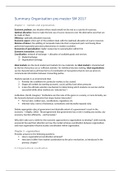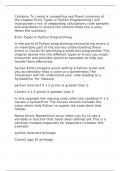Summary Organisation pre-master SM 2017
Chapter 1 – markets and organisati ons
Economic problem; any situation where needs would not be met as a scarcity of resources.
Optimal allocation; how to make the best use of scarce resources over the alternative uses that can
be made of them
Efficiency; optimally allocated resources
Economic aspect; when part of the problem deals with the (optimal) allocation of scarce resources
Division of labour; the splitting of composite tasks into their component parts and having these
performed separately (pervasive phenomenon in modern societies)
Economies of specialisation; higher output due to specialisation within firm
Economic transaction; exchange
Coordination; network of exchange -> allocation of available goods and services
1) Market Exchange
2) Organisation Exchange
Ideal markets are the stock market and markets for raw materials. An ideal market is characterised
by the fact that prices act as ‘sufficient statistics’ for individual decision making. Ideal organisations
can be characterised as all those forms of coordination of transactions that do not use prices to
communicate information between transacting parties.
Markets operate in an environment that:
1- Provides the conditions for particular markets to be created
2- Shapes all markets by exerting economic, social, political and other pressures
3- Is also the ultimate selection mechanism for determining which markets can survive and be
successful (while other markets are ‘selected out’)
Institutions (North, Douglas): “Institutions are the rules of the game in a society, or more formally, are
the humanly devised constraints that shape human interaction”.
Formal rules: written laws, constitutions, regulations etc.
Informal rules: norms of behaviour, conventions and internally imposed rules
Debate appropriate roles of government and desirable extent of a government’s reach in the
economy -> (Stiglitz, 2002): “Broad agreement that government has a role in making any society, any
economy, function efficiently – and humanely”.
Why did it take such a while for the economic approaches to organisations to develop? Until recently,
economist focused their attention on how the market achieves coordination between organisations
and most organisation theorist studies coordination within organisation.
Chapter 3 – organisations
Provides answers to the following questions:
How is organisational coordination achieved?
How does it differ from market coordination by the price mechanism, as introduced in the
previous chapter?
3.2 Organisati onal coordinati on
, Coase (1937) posited that organisations and markets as alternative coordination devices use
authority as the allocation of resources instead of the price mechanism.
Mintzberg (1979, 1989) synthesized organisational literature on the structure of organisations. He
developed a typology of organisational configurations. There are six types:
Direct Supervision Mutual Adjustment
Standardisation of work Standardisation of outputs
Standardisation of skills Standardisation of norms
1. Mutual adjustment
Achieves coordination by the simple process of informal communication (as between two
operating employees).
2. Direct supervision
Coordination is achieved by having one-person issue orders or instructions to several others
whose work interrelates (as when a boss tells others what is to be done, one step at a time).
3. Standardisation of work processes
Achieves coordination by specifying the work processes of people carrying out interrelated
tasks. The standards are developed in the techno structure, which is the part of the
organisation where staff outside the hierarchy who plan and control the work of others
(quality control engineers, budgeters, accountants and so forth) are located.
4. Standardisation of outputs
Chapter 1 – markets and organisati ons
Economic problem; any situation where needs would not be met as a scarcity of resources.
Optimal allocation; how to make the best use of scarce resources over the alternative uses that can
be made of them
Efficiency; optimally allocated resources
Economic aspect; when part of the problem deals with the (optimal) allocation of scarce resources
Division of labour; the splitting of composite tasks into their component parts and having these
performed separately (pervasive phenomenon in modern societies)
Economies of specialisation; higher output due to specialisation within firm
Economic transaction; exchange
Coordination; network of exchange -> allocation of available goods and services
1) Market Exchange
2) Organisation Exchange
Ideal markets are the stock market and markets for raw materials. An ideal market is characterised
by the fact that prices act as ‘sufficient statistics’ for individual decision making. Ideal organisations
can be characterised as all those forms of coordination of transactions that do not use prices to
communicate information between transacting parties.
Markets operate in an environment that:
1- Provides the conditions for particular markets to be created
2- Shapes all markets by exerting economic, social, political and other pressures
3- Is also the ultimate selection mechanism for determining which markets can survive and be
successful (while other markets are ‘selected out’)
Institutions (North, Douglas): “Institutions are the rules of the game in a society, or more formally, are
the humanly devised constraints that shape human interaction”.
Formal rules: written laws, constitutions, regulations etc.
Informal rules: norms of behaviour, conventions and internally imposed rules
Debate appropriate roles of government and desirable extent of a government’s reach in the
economy -> (Stiglitz, 2002): “Broad agreement that government has a role in making any society, any
economy, function efficiently – and humanely”.
Why did it take such a while for the economic approaches to organisations to develop? Until recently,
economist focused their attention on how the market achieves coordination between organisations
and most organisation theorist studies coordination within organisation.
Chapter 3 – organisations
Provides answers to the following questions:
How is organisational coordination achieved?
How does it differ from market coordination by the price mechanism, as introduced in the
previous chapter?
3.2 Organisati onal coordinati on
, Coase (1937) posited that organisations and markets as alternative coordination devices use
authority as the allocation of resources instead of the price mechanism.
Mintzberg (1979, 1989) synthesized organisational literature on the structure of organisations. He
developed a typology of organisational configurations. There are six types:
Direct Supervision Mutual Adjustment
Standardisation of work Standardisation of outputs
Standardisation of skills Standardisation of norms
1. Mutual adjustment
Achieves coordination by the simple process of informal communication (as between two
operating employees).
2. Direct supervision
Coordination is achieved by having one-person issue orders or instructions to several others
whose work interrelates (as when a boss tells others what is to be done, one step at a time).
3. Standardisation of work processes
Achieves coordination by specifying the work processes of people carrying out interrelated
tasks. The standards are developed in the techno structure, which is the part of the
organisation where staff outside the hierarchy who plan and control the work of others
(quality control engineers, budgeters, accountants and so forth) are located.
4. Standardisation of outputs





